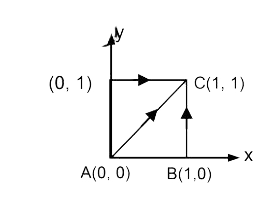A particle moves in the x-y plane under the action of a force →F such that the value of its linear momentum →P at any time t is Px=2 cost and py=2sint. What is the angle θ between →F and P at a given time t?
90∘
0∘
180∘
30∘
The correct Answer is:A
To solve the problem, we need to find the angle θ between the force vector →F and the momentum vector →P at any time t.
1. Define the momentum vector →P:
- Given:
Px=2cost,Py=2sint
- Therefore, the momentum vector can be expressed as:
→P=2cost^i+2sint^j
2. Calculate the force vector →F:
- The force is defined as the rate of change of momentum:
→F=d→Pdt
- Differentiate →P:
dPxdt=ddt(2cost)=−2sint
dPydt=ddt(2sint)=2cost
- Thus, the force vector is:
→F=−2sint^i+2cost^j
3. Use the dot product to find the angle θ:
- The dot product →F⋅→P is given by:
→F⋅→P=(−2sint)(2cost)+(2cost)(2sint)
- Simplifying this:
→F⋅→P=−4sintcost+4sintcost=0
4. Relate the dot product to the angle:
- The formula for the dot product in terms of the angle is:
→F⋅→P=|→F||→P|cosθ
- Since →F⋅→P=0, we have:
|→F||→P|cosθ=0
- This implies:
cosθ=0
5. Determine the angle θ:
- The angle θ for which cosθ=0 is:
θ=π2 radians=90∘
Conclusion:
The angle θ between the force →F and the momentum →P at any time t is 90∘.
- Given:
Px=2cost,Py=2sint
- Therefore, the momentum vector can be expressed as:
→P=2cost^i+2sint^j
- The force is defined as the rate of change of momentum:
→F=d→Pdt
- Differentiate →P:
dPxdt=ddt(2cost)=−2sint
dPydt=ddt(2sint)=2cost
- Thus, the force vector is:
→F=−2sint^i+2cost^j
- The dot product →F⋅→P is given by:
→F⋅→P=(−2sint)(2cost)+(2cost)(2sint)
- Simplifying this:
→F⋅→P=−4sintcost+4sintcost=0
- The formula for the dot product in terms of the angle is:
→F⋅→P=|→F||→P|cosθ
- Since →F⋅→P=0, we have:
|→F||→P|cosθ=0
- This implies:
cosθ=0
- The angle θ for which cosθ=0 is:
θ=π2 radians=90∘
The angle θ between the force →F and the momentum →P at any time t is 90∘.
Similar Questions
A particle moves in the xy-plane under the action of a force F such that the components of its linear momentum p at any time t and px=2cos t, py=2sin t. the angle between F and p at time t is
View SolutionA particle moves in the x-y plane under the action of a force →F such that its linear momentum →P at any time t is →P=2costˆi+2sintˆj. The angle between →F and →P at a given time t will be
View SolutionA particle moves in the xy plane under the influence of a force such that its linear momentum is →P(t)=A[ˆicos(kt)−ˆjsin(kt)], where A and k are constants. The angle between the force and momentum is
View SolutionA particle of mass m moves from A to C under the action of force →F=2xyˆi+y2ˆj , along different paths as shown in figure.
 View Solution
View SolutionA particle moves in x-y plane and at time t is at the point (t2,t3−2t), then which of the following is/are correct?
View SolutionThe linear momentum of a particle varies with times as p=a0+at+bt2. What s force and time relation ?
View SolutionA particle moves in xy-plane. The position vector of particle at any time is →r={(2t)ˆi+(2t2)ˆj}m. The rate of change of 0 at time t=2 second. ( where 0 is the angle which its velocity vector makes with positive x-axis) is :
View SolutionA particle moves in a straight line and its position x at time t is given by x2=2+t. Its acceleration is given by :-
View SolutionThe coordinates of a moving particle at any time t are given by x=ct and y=bt2. The speed of the particle is given by
View SolutionA particle is moving in x−y plane with y=x2 and Vx=4−2t. The displacement versus time graph of the particle would be
View Solution

